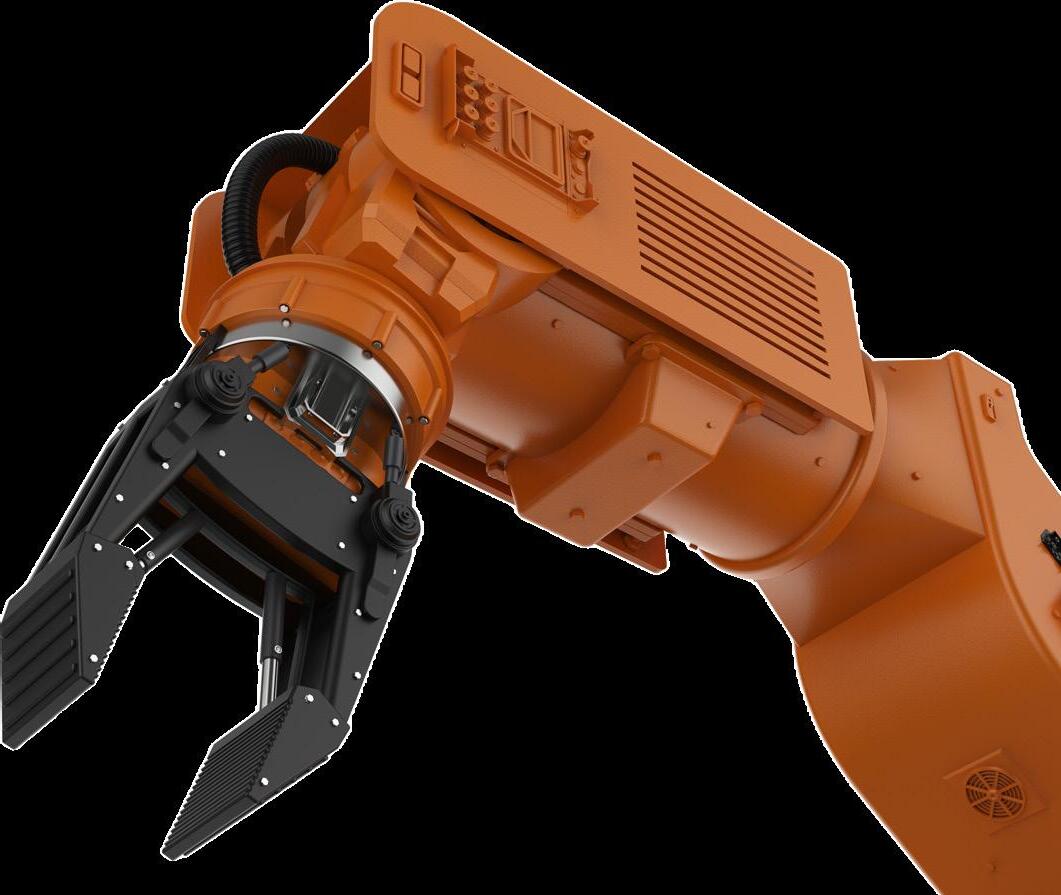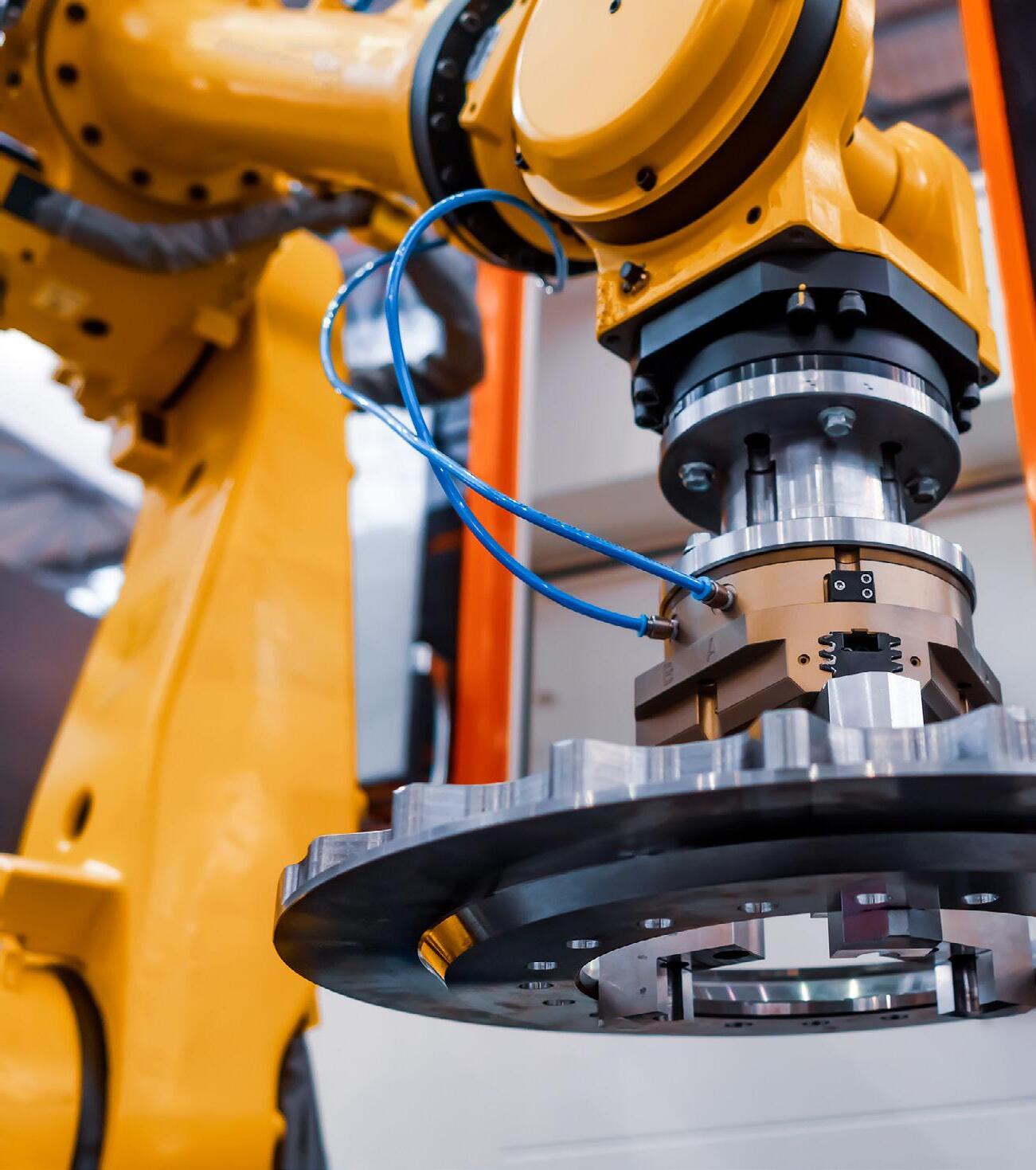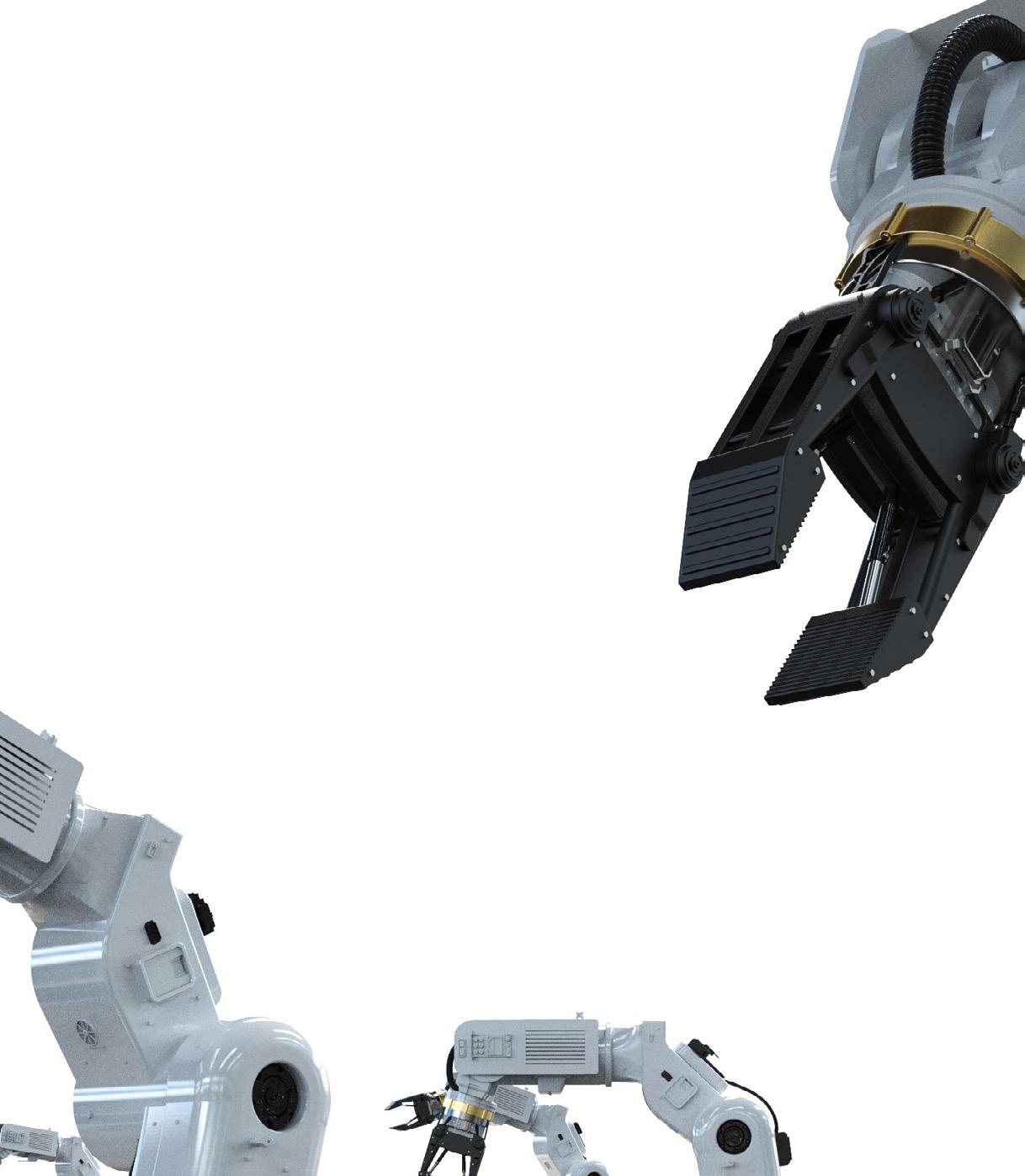FOCUSED FUTURE
MANUFACTURING







Last year, we published a report in partnership with Raconteur and The Manufacturer that looked at the state of the manufacturing industry. We said that manufacturers can no longer afford to debate whether they should invest in futureproofing their operations; it’s time to think about the actual ‘doing’. Where do we stand now, considering all that has happened in the past few years?
Overall, the sector is fairly resilient and most sub-verticals are bouncing back, however the industry desperately needs to be moving towards innovation. Henry Anson is the Managing Director of Hennik Research, a publisher that’s deeply rooted in the manufacturing industry. The company’s portfolio of titles include The Manufacturer and the Lean Management Journal. According to Anson, “there is an acceptance that change is inevitable”.
The manufacturing industry is no stranger to global disruptions (SARS in 2002, financial crash in 2008, Icelandic ash cloud in 2010, the Fukushima nuclear disaster in 2011, COVID-19, etc.). He says: “There is an understanding that there will be more of these seismic shocks in the future, caused by future pandemics, geo political uncertainty (trade wars – US/China) and climate change. “And consequently, there will be an accelerated adoption of Industry 4.0. There’s almost universal appreciation that more digitalized, automated manufacturers would have been better prepared to deal with the current pandemic and future crisis.”
So, it’s safe to assume that while digitalization may have been slowly becoming the norm, it now needs to be.
Digitalization is sweeping through the industry but is the change happening quickly enough?

The fourth industrial revolution is here and it’s all about realising the full potential of data connectivity. Connect the systems on your manufacturing shop floor and benefit from consolidated data, AI and real-world modelling - all of which can help you to develop new strategies across the entire business, from product conceptualisation and design right through to end-user consumption and after-sales service provision.
Essentially, it’s making the most of new tools and strategies to add value to what your business does and make your employees’ lives easier.
This is what digitalization should look like for the industry. But, the approach to ‘going digital’ has been very gradual, mostly because “it’s based on an immediate need or customer demand”, according to Kevin Bull, our Product Strategy Director. If you want to fully exploit the opportunities presented by digitalization, you need a broader, more strategic view of your business.
Just because you’re “going digital” doesn’t mean you must implement the entirety of that strategy in one huge step. Analysis and score-carding of the areas of highest expected value of return in comparison to expected effoart, cost or risk can be used to drive these decisions.
Bull recommends looking at your entire value chain. “Look deeply, often imaginatively, for opportunities to use data to drive improvements,” he says. At the simplest level, that might mean data integration – reducing waste by eliminating data entry activities which then frees up your employees’ time to focus on other tasks.
This is what office furniture manufacturer Orangebox did by installing Microsoft Dynamics 365 Field Service. At the highest level, it might mean consuming data being streamed from a multitude of sensors and using data analytics and machine learning to make predictions and suggest remedial actions.

“Or, it might mean developing computerised models of production environments, the so-called ‘digital twin’”, Bull continues. “This allow us to conduct “what if” scenarios before committing them to the real world.”
The problem isn’t that manufacturers don’t know what the opportunities are. Instead, the industry is being held back because businesses don’t know what’s achievable.
The terms that those of us in the IT world are throwing around can be ambiguous. Terms like Artificial Intelligence, Cognitive Services and Internet of Services are just words that don’t even begin to describe the business transformation opportunities that they represent. And even if you have some idea of what AI is, not everyone knows that it’s available as an online service that you can ‘plug into’ with relative ease.
So, it’s not surprising that many businesses do struggle to develop a coherent digital transformation strategy. Can you blame them when there’s not enough material out there to explain exactly what these IT terms mean?
To tackle this innovation bottleneck, you need to start empowering your employees with knowledge. Martin Clothier, our Technical Director, believes there’s a lot of untapped innovation within in-house teams.
“Every company has people on the shop floor who know the business, the processes and how to change and improve them. But they’re not IT people or software developers so they end up creating wonderful spreadsheet solutions that plan and run the whole business,” he says.
That leads to the common problem - the knowledge is siloed.
“To relieve that bottleneck, you can train those people to become citizen developers,” recommends Clothier. “They can then take innovative ideas and turn them into reality.”
“Train your employees to become citizen developers so they can take innovative ideas and turn them into reality.”

– Martin Clothier, Technical Director
Manufacturers are always working to innovate some part of their operations to keep up with the changes in demand and competition. But to ensure your journey to an innovative future will be largely free of hurdles, watch out for these red flags…
Saying “but we’ve always done it this way” demonstrates a lack of vision beyond your current systems
Reliance on Spreadsheeats
They can be complex, authors can be very protective and only represent a single person’s view of the business
Characterised by the popular phrase, “We don’t need anything complicated, all we do is make cake” (replace the word “cake” for manufactured item of your choice!)
If you do come across one or more, look into the root cause. What’s causing this inflexibility? Why is a particular employee/department so reluctant to let go of spreadsheets? What don’t your people understand about your processes?
You’ll find the answer is clear, efficient communication. Ensure all of your employees understand the benefits of innovation, whether it’s a process change or a new solution, and why the old ways can be improved, leading to a successful future.
“The fourth industrial evolution is more of a transition into realising the full potential of globally connected, intelligent, computerised systems. With that level of data connectivity, we can leverage the incredible advances in Artificial Intelligence and real-world modelling.”
– Kevin Bull, Product Strategy Director
Merely surviving isn’t the mentality a successful business should adopt. It’s not just technological changes that can transform an industry. There are also situations, some out of our control, that require us to quickly recognise them and adapt to ‘the new norm’. The COVID-19 crisis and Brexit are two key examples. The former is notably one that we’ve had little time to prepare for and have been forced to jump to action.
An Annual Global CEO Survey from PwC found that more than a quarter of CEOs in industrial manufacturing (IM) businesses felt “not very confident” about their company’s 12-month revenue growth. That was before COVID-19 happened so these concerns have most certainly been amplified since the survey was conducted.
And for good reason. PwC conducted another survey in May 2020, this time among financial leaders. They found 51% of CFOs expect a decrease in revenue of up to 25% as a result of the pandemic. So, how can manufacturers boost and solidify their revenue growth? By migrating to a more agile, innovative business model. Direct your cost-cutting measures towards lower priority areas and refocus resources on the high priority areas that can secure your future competitiveness. Your end-game is to enhance your business’ capabilities which is precisely where technology can help.
43% of manufacturers want to plan for growth but feel like the times are too uncertain and unstable. Quick agility is key to ensuring revenue growth, despite the challenges of an uncertain environment. Speed is of the essence here - anything that takes years to develop will probably be outdated by the time it’s ready to use. So, look for something with a shorter implementation time or a solution that can be implemented in increments.
The
Leaders understand the importance of technology. However, broad implementation is still pending, mostly because of the unstable environment.

There’s a recurring theme among the manufacturers who coped the best during the March 2020 national lockdowns - they were agile. Henry Anson, MD of Hennik Research, calls it being “sustainable”, though he adds: “In this instance, I mean building a sustainable business to last and that can withstand seismic shocks such as COVID-19.
“There will be a green element to this as many governments are looking to rebuild their domestic economies on the back of a zero-carbon agenda and will support companies and organisations that embrace this. This sustainability drive will include looking at new business models such as eCommerce, B2B2C and servitisation as manufacturers search for new and more sustainable revenue streams.”
In other words, the more agile your business operations can be, the faster you can adapt to this new world. Yet, only 14% of manufacturing business leaders believe the statement “we are agile and pursue new opportunities that emerge” which highlights the need to become more so. Here are three ways manufacturers can become more agile.
Traditionally for manufacturers, cost has been the biggest determining factor in sourcing raw materials and component parts. However, it might no longer be possible or viable to source entirely from a particular region. The COVID-19 crisis in particular has been instrumental in exposing the effects of disruption on global supply chains. Tackle any future issues by considering the following:
• Choosing suppliers from alternative countries where doing business may not be as complex, disruptive or expensive
• Optimising your existing plants so they’re operating as efficiently as possible. Automation and digitally-enabled workflows are particularly helpful here as they reduce manual work and boost workforce productivity
• Re-evaluating your global manufacturing and supply chain footprint. You may even need to shorten your overall supply chain cycle time so adapting to changing environments is much easier in future
• Preparing to extend to adjacent products that are countercyclical or based on their demand. For example, being able to manufacture PPE alongside or in place of your regular products
– Henry Anson, Managing Director
“Whilst cost will always be a big factor, shorter and stronger supply chains will now be a major focus - especially as some of the cost benefits of sourcing from low wage economies has dissipated with, for instance, a seven-fold increase in the cost of air freight.”
Despite the bevy of technological solutions available to the manufacturing industry, large-scale adoption is still rare. Digitalization tends to be very “piecemeal”, as Kevin Bull, our Product Strategy Director, calls it because ‘going digital’ is mostly based on need or market demand.
However, it needs to cascade throughout your whole business if you want to reap the full benefits. These steps will help:
• Digital capabilities need to be addressed from the top. Your senior leadership team needs to clearly communicate this to your wider team and ensure everyone shares a common goal.
• Look beyond information storage systems. A great ERP system can obviously be a huge benefit but it’s not just about consolidating your data. Also look at solutions to improve your asset performance and visibility, such as predictive maintenance, AI and machine learning.
“IM companies have been talking about and piloting new technology solutions for the past few years but have not broadly implemented them at scale.”
– PwC, The 23rd Annual Global CEO SurveyBridge the digital divide
There’s little point in investing in state-of-the-art technology if no-one in your business knows how to use it. Finding the right talent can be tricky too so you’ll need to upskill your employees. Fortunately, 77% of workers are willing to learn new skills or completely retrain to enhance their employability - so take advantage of that.
Bridging this digital divide can help your employees to act or think more proactively when it comes to innovation. This is what propels you towards agility. For example, you might need to perform additional quality assurance (QA) checks as a result of an increase in production volume and market demand. Employees who can think innovatively might have the idea to develop an app to assist with this data capture process. All it takes is a change in mindset and a relatively small amount of training.
“In just a few weeks, you can get people to a level where they’re able to create those sorts of apps to capture that data and automate from there,” says Clothier, Technical Director. “As soon as you capture data, you can automate data flows & make your employees’ lives much easier.”
By 2022, 54% of employees will need significant training, with 35% needing at least six months’ worth of time and resources.
For the best chances of success in a constantly evolving environment, your people must be willing to be agile too. Transformation is rarely a single-threaded process but how can businesses decide which trends demand urgent attention and which can be left on the back bench? Here are some important trends we think you can’t afford to ignore and why.
Shortages in the labor market and rising wages were already affecting manufacturers. Social distancing and continually changing regulations have added another layer of complexity. This is why the case for investment in automated technology is becoming increasingly attractive. Here are some benefits of replacing your manual processes with automation:
• Reduces the number of repetitive tasks which boosts productivity and efficiency
• Empowers your team to perform better and with a higher sense of worth
• Reduces the number of people needed to perform a particular manualheavy task
• Frees your team up to perform higher value-added work
• Helps you get the right work to the right people at the right time
• Increases visibility of your business processes if you can turn your data into a report
• Ultimately improves your bottom line
Once your business matures, the possibilities for automation deepen. Our Technical Director
Martin Clothier mentions machine learning and machine vision as potential opportunities. He says: “We can use the data collected and turn it into something clever like machine learning and machine vision. “All we have to do is point the phone at a product and machine vision can tell us what’s wrong with it. Or start to predict the level of returns based on historical data.”
Natural disasters, health emergencies and other geo-political problems can easily disrupt your sourcing operations and labour plans overnight. You might not be able to predict the unpredictable but you can use technology to increase your visibility of your operations and market. This can increase your chances of assuming ‘business as usual’.
Example:
Towns and villages being cut off from the road network and supply chain impacted
Data feeds available online

Analyse this data alongside customer and vendor data
You gain a few days of early warning so you can make a mitigation plan
A great ERP system sits at the heart of your technological transformation. This is because of its ability to integrate with multiple systems and consolidate data from different sources to create a single view of your business.
The benefits of an ERP system like Microsoft Dynamics 365 Finance & Operations:
• Improves sales demand forecasting Azure machine learning analyses your product sales histories and trains itself to select from five sophisticated statistical forecasting models
• Facilitates more efficient constraint management - the ERP comes with tools that can help you identify physical capacity constraints and plan their use so you can maximise throughput and minimise cost
• Unlocks proactive supplier collaboration - your suppliers will havecontrolled remote access to your ERP
• Sets dynamic safety stocks - rather than the blanket approach, the ERP provides automated methods for dynamically calculating appropriate statistical safety stock levels for individual products and groups of products
• Helps you achieve effective customer demand management - D365F&O sales order processing offers ‘available to promise’ and ‘capable to promise’ functionalities so your sales administrators can generate realistic confirmed ship and receipt dates against sales order lines
• Increases overall visibility of your business processes which improves your supply chain management
Learn more about the benefits of Dynamics 365 Finance & Operations for your supply chain here.
Case Study:
Investing in a modern ERP system transformed business operations for awardwinning tap manufacturer Greg Rowe. “It has finally given us full control, from the CRM level through to the recording of information into transactions at ERP level, joining up the whole circle,” said founder Greg Rowe.
A combination of the above technological solutions and the power of IoT can help form the basis for a smart, connected factory. How can factory connectivity benefit manufacturers?

Increased production and reduced costs
Production is more flexible
Reduced production cycle time
Enhanced quality
Improved staff productivity and operational efficiency gains
Better accuracy and reduced likelihood of human errors
Better prepared for the changing market
Enhanced Health and Safety
Technology plays such a huge role in business innovation, it’s easy to only think about that. But the other key components of innovation are your customers. It’s how you can put their experience and happiness first. The above solutions can help (especially if you can harness them to build a data-driven culture that strives to achieve a single version of the truth).
But there are non-technological strategies that can also help. Take personalisation, for example. Here are some benefits of providing your customers with exclusive, personalized goods/services:
• Allow customers to connect with your brand
• Boost customer satisfaction and experience
• Help customers feel special
• Creates buzz and excitement around your brand
• Drives sales
In this blog post, we’ve discussed how manufacturers are using personalisation in real life.
The good news is that none of these trends are particularly new. They’ve been around a long time; the difference now is the speed at which you innovate. And that’s what separates the businesses that thrive from the ones that are just surviving.
It starts with efficient change management and then working with a systems implementation partner. This can tackle any misunderstandings associated with the implementation process (such as the above), avoid potential pitfalls and enable your everyday users to use the new solutions to drive further innovation.
The recent pandemic, unfortunately, won’t be the last uncontrollable, unpredictable event to disrupt the norm. Here’s how we can ensure we’re better prepared next time.
Your employees, customers, partners, owners - examine exactly what’s at stake for all these people and what matters the most to them. Knowing this will help you prioritise actions in the event of unfavourable circumstances.
If you know what your business’ best strengths are, you can apply them to benefit your stakeholders. For example, in times of crisis, you might be able to adopt a unique logistics network to transport items of aid to people in need, shift production to create medical supplies or quickly spin up other new online sales channels.
Being able to react like this has been a saviour to some businesses during the COVID-19 pandemic but you should try to collaborate as closely with your ecosystem of customers and suppliers as possible because you never know what strengths they could identify that you never knew you had. It also ensures your choices align with your business values.
Our Product Strategy Director, Kevin Bull, agrees: “Online collaboration with supply chain partners has solved issues in component or material availability.”
And then, of course, there are the businesses who were technologically empowered enough to continue working at home and limit the impact of a crisis. For example, video conferencing software and apps to monitor your throughput, QA checks and returns can keep your employees connected and productive regardless of their location.
It’s easy to only involve your senior leadership when it comes to making strategical changes. But those changes will most affect your everyday users so you should engage with and gather input from the wider team too. Keeping the relevant teams in the loop is a great change management tactic, helping your employees feel involved and you to get their buy-in more easily. It’s not productive to leave your entire team in charge of sign-offs, though, so you could nominate representatives for each key department (or get your employees to).
At the centre of a successful strategical change sits great leadership. Whether it’s a global crisis that pushes your business to action or it’s time to upgrade your legacy ERP system, you need strong leaders to lead your teams to success.
When confronted with change, many businesses naturally fall back to their old ways. They might have been driven to improve their processes, boost efficiency and so on but if it starts getting difficult, they tend to revert to what they had. According to Lee Walker, Business Consultant, you should combat this by making sure the old ways are no longer available. “When you choose your go-live date, go for it. If everyone’s learning these new processes and it starts getting difficult, make sure the old way isn’t available,” he advises. That way, you’re completely setting your business on the path to innovation and further success.
Phone: 888.209.3342
Email: ariel.miller@columbusglobal.com

